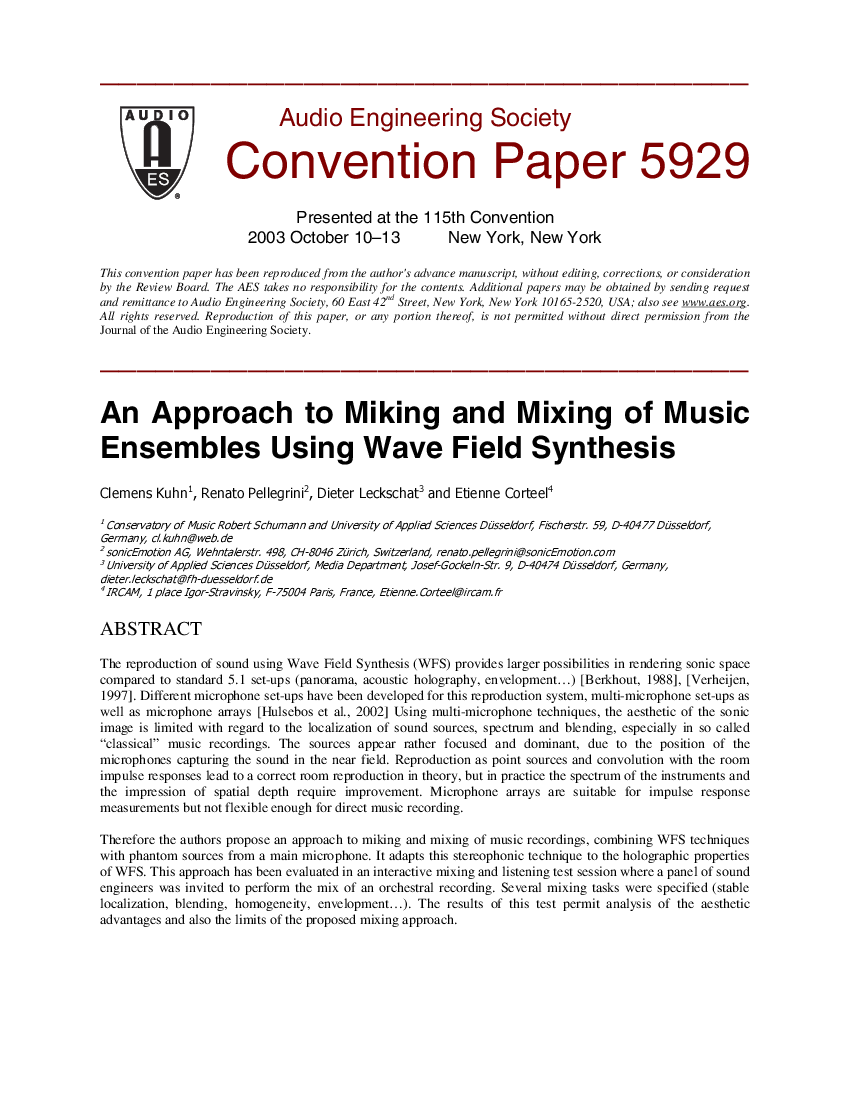Home / Publications / E-library page
You are currently logged in as an
Institutional Subscriber.
If you would like to logout,
please click on the button below.
Home / Publications / E-library page
Only AES members and Institutional Journal Subscribers can download
The reproduction of sound using Wave Field Synthesis (WFS) provides larger possibilities in rendering sonic space compared to standard 5.1 set-ups (panorama, acoustic holography, envelopment) [Berkhout, 1988], [Verheijen, 1997]. Different microphone set-ups have been developed for this reproduction system, multi-microphone set-ups as well as microphone arrays [Hulsebos et al., 2002] Using multi-microphone techniques, the aesthetic of the sonic image is limited with regard to the localization of sound sources, spectrum and blending, especially in so called `classical` music recordings. The sources appear rather focused and dominant, due to the position of the microphones capturing the sound in the near field. Reproduction as point sources and convolution with the room impulse responses lead to a correct room reproduction in theory, but in practice the spectrum of the instruments and the impression of spatial depth require improvement. Microphone arrays are suitable for impulse response measurements but not flexible enough for direct music recording. Therefore the authors propose an approach to miking and mixing of music recordings, combining WFS techniques with phantom sources from a main microphone. It adapts this stereophonic technique to the holographic properties of WFS. This approach has been evaluated in an interactive mixing and listening test session where a panel of sound engineers was invited to perform the mix of an orchestral recording. Several mixing tasks were specified (stable localization, blending, homogeneity, envelopment). The results of this test permit analysis of the aesthetic advantages and also the limits of the proposed mixing approach.
Author (s): Kuhn, Clemens; Pellegrini, Renato; Corteel, Etienne; Leckschat, Dieter
Affiliation:
Conservatory of Music Robert Schumann and University of Applied Sciences Düsseldorf, Düsseldorf, Germany ; sonicEmotion AG, Zürich, Switzerland ; University of Applied Sciences Düsseldorf, Media Department, Düsseldorf, Germany ; IRCAM, Paris, France
(See document for exact affiliation information.)
AES Convention: 115
Paper Number:5929
Publication Date:
2003-10-06
Import into BibTeX
Session subject:
Multichannel Audio
Permalink: https://aes2.org/publications/elibrary-page/?id=12469
(761KB)
Click to purchase paper as a non-member or login as an AES member. If your company or school subscribes to the E-Library then switch to the institutional version. If you are not an AES member Join the AES. If you need to check your member status, login to the Member Portal.

Kuhn, Clemens; Pellegrini, Renato; Corteel, Etienne; Leckschat, Dieter; 2003; An Approach to Miking and Mixing of Music Ensembles Using Wave Field Synthesis [PDF]; Conservatory of Music Robert Schumann and University of Applied Sciences Düsseldorf, Düsseldorf, Germany ; sonicEmotion AG, Zürich, Switzerland ; University of Applied Sciences Düsseldorf, Media Department, Düsseldorf, Germany ; IRCAM, Paris, France; Paper 5929; Available from: https://aes2.org/publications/elibrary-page/?id=12469
Kuhn, Clemens; Pellegrini, Renato; Corteel, Etienne; Leckschat, Dieter; An Approach to Miking and Mixing of Music Ensembles Using Wave Field Synthesis [PDF]; Conservatory of Music Robert Schumann and University of Applied Sciences Düsseldorf, Düsseldorf, Germany ; sonicEmotion AG, Zürich, Switzerland ; University of Applied Sciences Düsseldorf, Media Department, Düsseldorf, Germany ; IRCAM, Paris, France; Paper 5929; 2003 Available: https://aes2.org/publications/elibrary-page/?id=12469
@article{kuhn2003an,
author={kuhn clemens and pellegrini renato and corteel etienne and leckschat dieter},
journal={journal of the audio engineering society},
title={an approach to miking and mixing of music ensembles using wave field synthesis},
year={2003},
number={5929},
month={october},}